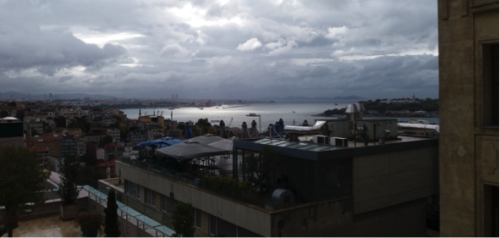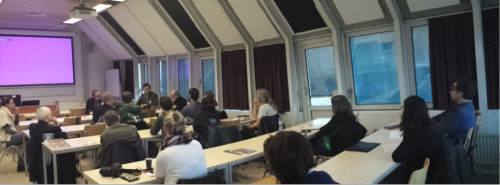
ANAMED Fellow Güzin Eren writes about her research and answers an immediate question she gets when talking about her research: “Why are you so interested in monumental buildings?”…
Taking a break at the terrace of ANAMED from my dissertation work is always a pleasure, as one faces a nice panorama of central Istanbul. Either by climbing up to the top of a building – exactly where I am right now – or just by walking on the streets of this city, you witness its deep history, the city that was once Byzantium, then Constantinople, later Istambol, Stambol, and finally modern Istanbul. The richness of this continuous occupation is reflected in its edifices: remains of Roman palaces, city walls, columns and aqueducts, Byzantine churches, Ottoman palaces, mosques – occasionally converted from earlier religious buildings – and the modern business district with its skyscrapers adorn Istanbul. A living history before your eyes…
Here at ANAMED I continue my work on monumental architecture at Sardis, the capital city of ancient Lydia. Like Istanbul, Sardis has an extensively long occupation history, beginning in the Bronze Age (~ 3400 years ago) and running into the Byzantine era (~ 700 years ago). Sardis was also adorned by elite and public buildings throughout the centuries. The most attractive episode of Sardis to me, however, is when the city was the capital of a mighty sovereignty that covered most of western Anatolia, and housed a native Anatolian population, the Lydians, who produced the earliest coins of the world, buried their royal families under giant piles of earth – so huge that these tumuli create landmarks on the landscape – and embellished their city with marvellous terrace walls and fortifications.

The Lydian tumuli with Sardis in the background.
http://www.sardisexpedition.org/en/essays/latw-cahill-city-of-sardis#introduction
When I talk about my research, one of the immediate questions I get is “Why are you so interested in monumental buildings?” Growing up in the midst of a rich assemblage of monuments in Istanbul could have been the catalyst. I guess wandering around in a city of culturally blended monuments since childhood triggered my curiosity. I began asking questions early on: How did people in the past really build such huge structures? Who designed them and who built them? Why were they built so differently from each other? And, why were they built so big anyway? I found myself dabbling with these questions more intensely when I was a college student in the Department of Urban Planning at Istanbul Technical University (ITU), and surprisingly (!) these questions now form more or less the core of my archaeological work on Lydian monuments. Besides, the fact that investigating monuments helps us discover so much about past peoples and societies is incredibly exciting to me. Just imagine that by looking at monuments you place yourself in a puzzle where your brain is occupied with diverse practices of long-deceased people, from their technologies – such as quarrying, transportation, construction equipment, and so forth – to economies, from artistic traditions to cultural origins and influences, from social organization to ritual practices and ideologies. These themes, all of which can be centered on monuments, continue to be widely discussed today.

The monumental terrace walls and fortifications of Sardis.
http://www.sardisexpedition.org/en/essays/latw-cahill-city-of-sardis
Such discussions recently took place during a workshop, SETinSTONE I: Constructing Monuments and Perceiving Monumentality, organized by Prof Ann Brysbaert of Leiden University and her team (https://www.universiteitleiden.nl/en/events/2016/12/constructing-monuments-and-perceiving-monumentality). This workshop brought together several scholars from around the world in the consideration of monuments that belong to different time periods and geographical zones. It was a privilege to be able to attend this workshop with ANAMED support and to have a voice in the discussions of what monumental architecture is or can be, how archaeologists expose, study, and interpret monuments, and how we can better the ways in which we perceive and understand them.

Scholars in discussion during the monumentality workshop at Leiden University.
An important outcome of this two-day workshop was the consensus that monuments are culture-specific, local constructs that mirror their own time and cultures. Therefore, instead of attempting to find a universal definition of what is intended by monumental construction, we should try and understand monumentality, that is, the long-standing relationship between monuments and people. By people, I mean the people who built and used monuments in the past, people who viewed, partly reshaped, and continued to use the past monuments in the past, and us, who still view, reuse, sometimes even destroy, and try to make sense of them all.
Yes, we might not be able to find a universal definition for the monumental. Nevertheless, monuments endure and outlive their own time, and monumental building practice never ceases. Therefore, people will continue to make bonds with monuments and this connection-making between people and monuments is universal. To me, this is why monuments are interesting subjects. Any research that places monuments at its center becomes not only about various aspects of the past but also relevant to today’s people and their worlds; just like the way I think when looking at Istanbul from the terrace of ANAMED. Maybe now, standing in front of a monument, you also will think about how the monument makes you feel…

